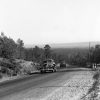calsfoundation@cals.org
Black Fork Mountain Wilderness
The Black Fork Mountain Wilderness is located in the Ouachita National Forest in western Arkansas and eastern Oklahoma. At an elevation of 2,403 feet, the east-west-oriented Black Fork Mountain, formed by a geologic uplift, features rock screes, or flows. The large rock flows, sometimes called “glaciers,” and sandstone bluffs stand above a forest dominated by oak and shortleaf pine.
The U.S. Congress designated 13,139 acres as the Black Fork Mountain Wilderness in 1984. Managed by the U.S. Forest Service of the U.S. Department of Agriculture and shared by Oklahoma and Arkansas (Arkansas has approximately 8,350 acres, while Oklahoma has approximately 4,789 acres), this area contains the thirteen-mile-long rugged ridge of Black Fork Mountain. In both states, the ridge rises to scenic overlooks that offer spectacular vistas of this region. Lower slopes are heavily forested with shortleaf pine, blackjack oaks, and ancient dwarf oaks. The northern slopes support hardwoods with an open understory. Slopes range from a five percent grade at the base to almost vertical near the top in Oklahoma.
The Ouachita National Recreation Trail runs along the east side of the wilderness with a spur trail, the Black Fork Mountain Trail, running to the ridge-top. After the spur trail ends, one can hike along the top into Oklahoma. The top features a forest of dwarf oaks and grass-like vegetation, including several unique plant species such as serviceberry and granddaddy graybeard hidden away in small coves. The six-mile-long Black Fork Mountain Trail passes several pioneer sites dating back to the late 1800s as it winds its way to the top of Black Fork Mountain, more than 2,400 feet above sea level. There are no developed trails in the Oklahoma portion of the wilderness, but a parking area is provided two miles north of Page, Oklahoma, on County Road 1040. The hiking is considered difficult.
The headwaters of Big Creek, in Oklahoma, and the Ouachita River, in Arkansas, run along the southern wilderness boundary, but water sources are either slim to nonexistent in the interior of the wilderness. Two small springs on the mountain flow most of the year. Few humans ever walk on Black Fork Mountain.
For additional information:
Black Fork Mountain Wilderness. U.S. Forest Service. http://www.fs.fed.us/r8/ouachita/recreation/wilderness/blackfork.shtml (accessed April 5, 2022).
“Black Fork Mountain Wilderness.” Wilderness.net. https://wilderness.net/visit-wilderness/?ID=56 (accessed April 5, 2022).
Ronald E. Krupa
U.S. Forest Service
 Environment
Environment Ouachita Mountains
Ouachita Mountains




Comments
No comments on this entry yet.